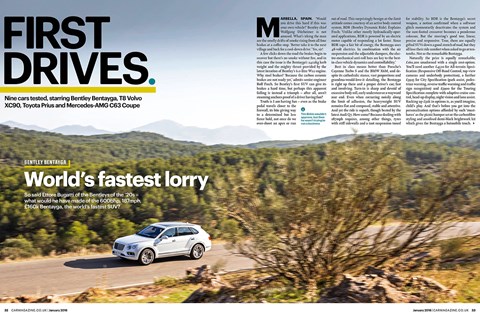► CAR Interactive: your say on our stories
► Each month we search for the best comments
► The best reader feedback on web, Facebook and Twitter – and the post
Mercedes’ F1 version of Alien: via email
It’s hard to believe that a place such as Mercedes’ ‘Holy Halls’ (CAR, January) really exists, but thank you for taking us there. The pictures are simply mesmerising, particularly that shot on page 82 showing all the F1 cars lining the walls in cocoons like some automotive version of Alien. So much history yet so little apparent order. Not very German, but way cool.
Leigh Cleeves
Those Lexus protrusions: via email
Like Stephen Bayley (CAR, January) I too have often wondered what those little plastic protrusions on the rear wheelarches of cars such as your long-term Lexus NX are for. I’m no car designer or legislator, but I’ve always assumed they are put there to comply with Construction & Use regulations. The legislation from VOSA on SVA testing (slightly different than homologation, I admit) states that on protrusions beyond the bodywork, possible reasons for failure include: ‘Where a wheel projects beyond the vehicle body plan form by more than 30mm’. In English I think this means that, when viewed from above, any more than 3cm of wheel sticking out beyond the bodywork – and that includes the wheelarches – is a fail. I’m guessing this can cause an issue where rear wheelarches are aerodynamically sculpted into rear end designs, hence the ‘cheat tags’ (not another ‘cheat’, I hear you cry, best not go there…). I’d blame SUVs and crossovers if I were you, I don’t remember seeing them on older cars. Nice edition by the way, and loving the BMW M2 cover story. Whatever you pay your photographers, it isn’t enough.
Mike Spencer

Bayley vs Lexus: via email
Those Lexus NX design results in full: Stephen Bayley 0, Nobuyuki Tomatsu 1.
Martin Lewis
On Merc’s upcoming EVs: via car online
The Tesla quake continues. But the idea that Tesla might be vulnerable to existing competition is ludicrous. The only way to compete with Tesla is to have breakthrough designs of battery, drive, construction, styling etc, build them on a greenfield site (with no costs associated with ICE production to fund) and a willingness to lose tens of thousands of dollars on every car you build for 5-10 years. Does this sound like anyone you can think of? Apple and, er, no-one else springs to my mind. Everyone else is toast unless they get a grip on the problem right now. Low-volume producers such as Rolls, Jag and Aston are best placed, but the bigger they are the harder they will fall unless they recognise the size of the threat and act quickly.
Bernie Harper
Mirai styling decoded: via email
With regard to the Toyota Mirai (CAR, December), it has taken me a few months to work it out but I have now deciphered where I have seen this ‘styling’ before. This is obviously the bastard lovechild of a 1986 Subaru XT turbo and a 2006 Seat Toledo with the full body kit and the BBS 18s! By some queer coincidence I have been fortunate enough to have owned an example of each and I still rate both as a leftfield choice, but full of quirks and character – I might even consider hydrogen power when I go to trade in the Cactus!
Clive Douglas
Bandits at ten-to-two! Via email
As an Australian reader, I was enjoying reading Ben Oliver’s drive on the Stuart Highway (CAR, January) until I saw his hands on the steering wheel in the ten-to-two position when, only 60 pages earlier, Mark Walton had voiced his frustration at drivers who steer this way. I wonder if Ben was getting some tips on high-speed driving from the local constabulary in the photo on page 113? Either way, it seems it’s not only CAR readers who need Mark’s advice.
Grant Cairns
 Madness in the Outback: via email
Madness in the Outback: via email
I enjoyed Ben Oliver’s piece on driving a Bentley across the Australian Outback at 200mph (CAR, January). On the face of it this was a rather gratuitous escapade, but I found it made a visceral and tangible connection between the headline top-speed figures which we all take for granted when comparing supercar specifications and the harsh reality of actually driving a real car at top whack. Goodness only knows how the Northern Territory can possibly justify such a speeding policy in the modern world (especially in Australia) – it’s like an English county suddenly deciding to reinstate smoking in pubs. I cannot defend it, but it kind of made me smile inside.
Hector Ramirez
On BMW gesture control: via car online
The irony, of course, is that people have been making hand gestures at BMW drivers since the late ’80s
Squelchuk
Too soon to forgive Volkswagen? Via email
Greg Fountain’s defence of VW (CAR, January), on the basis that they build a whole heap of exciting cars culminating in the Golf GTI Clubsport, is flawed. No matter how much he would like to forgive them their dieselgate sins, you simply cannot paper over such cynical rulebreaking. The fact that the Clubsport does look to be a hoot and that it’s certainly true a world without Porsche, Lamborghini and Bentley would be a poorer place for petrolheads is neither here nor there. That, in fact, is the tragedy of it, that a manufacturer we held in such high esteem should fall so spectacularly from grace. Forgiveness may perhaps follow, but it’s way too soon.
Alan Swift
Golf R vs S3, American style: via email
Ben Barry invited readers to compare the VW Golf R and Audi S3 (CAR, December). It seemed like a good idea but I don’t think that Ben had the US market in mind. In the US there is no Audi S3 hatchback. The Audi S3 saloon (sedan) starts at $42,500 and there is no manual transmission option, whilst the Golf R with a manual gearbox is $36,470 and with a DSG it’s $37,570. I think this price difference says a lot about the relative positioning of the two cars in the US and why directly comparing the two may not be relevant. The Golf would win on price and equipment on the most basic level. The UK buyer is very lucky to be able to compare these two cars at such similar price points.In fact, the UK car buyer is luckier for a number of reasons. In the UK the buyer can choose between three or five doors, the US buyer can only have five. The UK buyer can choose between 18in and 19in wheels. This is a choice dictated by which flavour of Golf R you buy in the US since only cars with DCC and Nav have 19in wheels. The UK buyer has a far wider range of paint colours and options to choose from. You can build the Golf you like. Please spare a little sympathy for the US performance hatch buyer – we have to count ourselves lucky that we can buy a hot hatch at all.
Mark Wheeler

On Porsche designer getting VW design job: via CAR online
Walter De’Silva is a great designer. As chief stylist of the Volkswagen group he had perhaps too many restrictions, though under his guide the once boring Golf developed into one of the best-looking compact cars out there. He also improved the design of VWs quite a lot, at least more than his forerunners. The A5 and the (still too) subtle but successful development of Audi design also counts among his greatest successes. His best design however was the Alfa 156. It will be interesting to see how Porsche designer Michael Mauer will perform. The Cayenne and Panamera are not exactly what I would call top car design.
jumbojet
Via CAR online
This is really great: ‘Porsche’s styling chief, Michael Mauer, will also head up design across the VW Group’. Most people will be bemused to know that Porsche had a ‘styling chief’.
stolto
My horse, my horse: via email
‘In 20 years,’ says Gavin Green (CAR, January) ‘the oil-burning engine, like the horse before it, will be consigned to the scrapheap.’ I have a horse. He’s called Alan, and he’s alive and well.
Donald Dewar
Canine dissent: via email

Left magazine open on picture of Bentley Bentayga. Enough said!
Tim Skinner

Slippery when huge: letter of the month
So, according to your review (CAR, January) we have the pursuit of superior aerodynamics to thank/blame for the Mk4 Prius’s challenging face. I imagine that fact will go unnoticed among Prius owners. I was, however, briefly impressed that Toyota would forgo showroom appeal in the interests of slaving on our behalf to provide us with a more efficient car. I say ‘briefly’ because moments later I read your review of the Bentley Bentayga, a polar opposite car if ever there was one, and discovered that despite a frontal area with its own postcode, ‘Bentayga is without peer, thanks in part to its remarkably slippery drag-coefficient of just 0.24’. That’s the same drag-coefficient as the Prius then. Can that be possible? If so, Toyota seems to have been caught napping or Bentley is in cahoots with the devil. My guess is the latter.
Alistair Drysdale